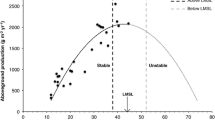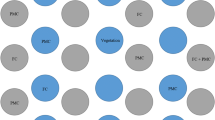Abstract
Tidal marsh degradation has been attributed to a number of different causes, but few studies have examined multiple potential factors at the same sites. Differentiating the diverse drivers of marsh loss is critical to prescribing successful interventions for conservation and restoration of this important habitat. We evaluated two hypotheses for vegetation loss at two marshes in Long Island Sound (LIS): (1) marsh submergence, caused by an imbalance between sea-level rise and marsh accretion, and (2) defoliation associated with herbivory by the purple marsh crab, Sesarma reticulatum. At our western LIS site, we found no evidence of herbivory: crabs were scarce, and crab-exclusion cages provided no benefit. We attribute degradation at that site to submergence, a conclusion supported by topographic and hydrologic data showing that loss of vegetation occurred only in wetter parts of the marsh. In contrast, at our central LIS site, our observations were consistent with herbivory as a driving force: There were substantial populations of Sesarma, crab-exclusion cages allowed plants to thrive, and vegetation loss took place across a variety of elevations. We also analyzed soil conditions at both sites, in order to determine the signatures of different degradation processes and assess the potential for restoration. At the submergence site, unvegetated soils exhibited high bulk density, low organic content, and low soil strength, posing significant biogeochemical challenges to re-colonization by vegetation. At the herbivory site, unvegetated soils had a characteristic “riddled-peat” appearance, resulting from expansion and erosion of Sesarma burrow networks. The high redox potential and organic content of those soils suggested that revegetation at the herbivory site would be likely if Sesarma populations could be controlled before erosion leads to elevation loss.









Similar content being viewed by others
References
Altieri, A.H., M.D. Bertness, T.C. Coverdale, N.C. Herrmann, and C. Angelini. 2012. A trophic cascade triggers collapse of a salt-marsh ecosystem with intensive recreational fishing. Ecology 93: 1402–1410.
Altieri, A.H., M.D. Bertness, T.C. Coverdale, E.E. Axelman, N.C. Herrmann, and P.L. Szathmary. 2013. Feedbacks underlie the resilience of salt marshes and rapid reversal of consumer-driven die-off. Ecology 94: 1647–1657. doi:10.1890/12-1781.1.
Anisfeld, S.C., T.D. Hill, and D.R. Cahoon. 2016. Elevation dynamics in a restored versus a submerging salt marsh in Long Island Sound. Estuarine, Coastal and Shelf Science 170: 145–154. doi:10.1016/j.ecss.2016.01.017.
Bertness, M.D., C.P. Brisson, M.C. Bevil, and S.M. Crotty. 2014a. Herbivorsy drives the spread of salt marsh die-off. Plos One 9: e92916.
Bertness, M.D., C.P. Brisson, T.C. Coverdale, M.C. Bevil, S.M. Crotty, and E.R. Suglia. 2014b. Experimental predator removal causes rapid salt marsh die-off. Ecology Letters 17: 830–835. doi:10.1111/ele.12287.
Bertness, M.D., C. Holdredge, and A.H. Altieri. 2009. Substrate mediates consumer control of salt marsh cordgrass on Cape Cod, New England. Ecology 90: 2108–2117.
Bertness, M.D., and G.H. Leonard. 1997. The role of positive interactions in communities: lessons from intertidal habitats. Ecology 78: 1976–1989. doi:10.1890/0012-9658(1997)078[1976:tropii]2.0.co;2.
Boesch, D.F., and R.E. Turner. 1984. Dependence of fishery species on salt marshes—the role of food and refuge. Estuaries 7: 460–468. doi:10.2307/1351627.
Chmura, G.L., S.C. Anisfeld, D.R. Cahoon, and J.C. Lynch. 2003. Global carbon sequestration in tidal, saline wetland soils. Global Biogeochemical Cycles 17. doi 10.1029/2002gb001917.
Coverdale, T.C., A.H. Altieri, and M.D. Bertness. 2012. Belowground herbivory increases vulnerability of New England salt marshes to die-off. Ecology 93: 2085–2094.
Coverdale, T.C., M.D. Bertness, and A.H. Altieri. 2013. Regional ontogeny of New England salt marsh die-off. Conservation Biology 27: 1041–1048. doi:10.1111/cobi.12052.
D’Alpaos, A., S.M. Mudd, and L. Carniello. 2011. Dynamic response of marshes to perturbations in suspended sediment concentrations and rates of relative sea level rise. Journal of Geophysical Research-Earth Surface 116: F04020. doi:10.1029/2011jf002093.
Davidson, T.M., and C.E. de Rivera. 2010. Accelerated erosion of saltmarshes infested by the non-native burrowing crustacean Sphaeroma quoianum. Marine Ecology: Progress Series 419: 129–136. doi:10.3354/meps08836.
Day, J.W., G.P. Shaffer, L.D. Britsch, D.J. Reed, S.R. Hawes, and D. Cahoon. 2000. Pattern and process of land loss in the Mississippi Delta: a spatial and temporal analysis of wetland habitat change. Estuaries 23: 425–438.
Deegan, L.A., D.S. Johnson, R.S. Warren, B.J. Peterson, J.W. Fleeger, S. Fagherazzi, and W.M. Wollheim. 2012. Coastal eutrophication as a driver of salt marsh loss. Nature 490: 388–392. doi:10.1038/nature11533.
DeLaune, R.D., J.A. Nyman, and W.H. Patrick Jr. 1994. Peat collapse, ponding and wetland loss in a rapidly submerging coastal marsh. Journal of Coastal Research 10: 1021–1030.
Elmer, W.H., J.A. LaMondia, S. Useman, I.A. Mendelssohn, R.W. Schneider, M.M. Jimenez-Gasco, R.E. Marra, and F.L. Caruso. 2013. Sudden vegetation dieback in Atlantic and Gulf Coast salt marshes. Plant Disease 97: 436–445. doi:10.1094/pdis-09-12-0871-fe.
Fagherazzi, S., G. Mariotti, P.L. Wiberg, and K.J. McGlathery. 2013. Marsh collapse does not require sea level rise. Oceanography 26: 70–77.
Gunnell, J.R., A.B. Rodriguez, and B.A. McKee. 2013. How a marsh is built from the bottom up. Geology 41: 859–862. doi:10.1130/g34582.1.
Hill, T.D., and S.C. Anisfeld. 2015. Coastal wetland response to sea level rise in Connecticut and New York. Estuarine, Coastal and Shelf Science 163: 185–193. doi:10.1016/j.ecss.2015.06.004.
Holdredge, C., M.D. Bertness, and A.H. Altieri. 2009. Role of crab herbivory in die-off of New England salt marshes. Conservation Biology 23: 672–679. doi:10.1111/j.1523-1739.2008.01137.x.
Hughes, Z.J., D.M. FitzGerald, C.A. Wilson, S.C. Pennings, K. Wieski, and A. Mahadevan. 2009. Rapid headward erosion of marsh creeks in response to relative sea level rise. Geophysical Research Letters 36: 5. doi:10.1029/2008gl036000.
Kirwan, M.L., G.R. Guntenspergen, A. D’Alpaos, J.T. Morris, S.M. Mudd, and S. Temmerman. 2010. Limits on the adaptability of coastal marshes to rising sea level. Geophysical Research Letters 37, L23401. doi:10.1029/2010gl045489.
Kirwan, M.L., and J.P. Megonigal. 2013. Tidal wetland stability in the face of human impacts and sea-level rise. Nature 504: 53–60. doi:10.1038/nature12856.
Kirwan, M.L., A.B. Murray, J.P. Donnelly, and D.R. Corbett. 2011. Rapid wetland expansion during European settlement and its implication for marsh survival under modern sediment delivery rates. Geology 39: 507–510. doi:10.1130/g31789.1.
Mariotti, G., and S. Fagherazzi. 2013. Critical width of tidal flats triggers marsh collapse in the absence of sea-level rise. Proceedings of the National Academy of Sciences of the United States of America 110: 5353–5356. doi:10.1073/pnas.1219600110.
Morris, J.T., P.V. Sundareshwar, C.T. Nietch, B. Kjerfve, and D.R. Cahoon. 2002. Responses of coastal wetlands to rising sea level. Ecology 83: 2869–2877.
Redfield, A.C. 1965. Ontogeny of a salt marsh estuary. Science 147: 50. doi:10.1126/science.147.3653.50.
Reed, D.J. 1990. The impact of sea-level rise on coastal salt marshes. Progress in Physical Geography 14: 465–481. doi:10.1177/030913339001400403.
Rybczyk, J.M., and D.R. Cahoon. 2002. Estimating the potential for submergence for two wetlands in the Mississippi River Delta. Estuaries 25: 985–998.
Seiple, W., and M. Salmon. 1982. Comparative social-behavior of 2 grapsid crabs, Sesarma-reticulatum (Say) and Sesarma-cinereum (Bosc). Journal of Experimental Marine Biology and Ecology 62: 1–24. doi:10.1016/0022-0981(82)90213-1.
Shepard, C.C., C.M. Crain, and M.W. Beck. 2011. The protective role of coastal marshes: a systematic review and meta-analysis. Plos One 6.
Smith, S.M., and C.W. Green. 2015. Sediment suspension and elevation loss triggered by Atlantic mud fiddler crab (Uca pugnax) bioturbation in salt marsh dieback areas of southern New England. Journal of Coastal Research 31: 88–94. doi:10.2112/jcoastres-d-12-00260.1.
Smith, S.M., K.C. Medeiros, and M.C. Tyrrell. 2012. Hydrology, Herbivory, and the Decline of Spartina patens (Aiton) Muhl. in Outer Cape Cod Salt Marshes (Massachusetts, USA). Journal of Coastal Research 28: 602–612. doi:10.2112/jcoastres-d-10-00175.1
Smith, S.M., M.C. Tyrrell, and M. Congretel. 2013. Palatability of salt marsh forbs and grasses to the purple marsh crab (Sesarma reticulatum) and the potential for re-vegetation of herbivory-induced salt marsh dieback areas in Cape Cod (Massachusetts, USA). Wetlands Ecology and Management 21: 263–275. doi:10.1007/s11273-013-9298-2.
Swanson, R.L., and R.E. Wilson. 2008. Increased tidal ranges coinciding with Jamaica Bay development contribute to marsh flooding. Journal of Coastal Research 24: 1565–1569. doi:10.2112/07-0907.1.
Turner, R.E. 2004. Coastal wetland subsidence arising from local hydrologic manipulations. Estuaries 27: 265–272.
Turner, R.E. 2010. Beneath the salt marsh canopy: loss of soil strength with increasing nutrient loads. Estuaries and Coasts 34: 1084–1093. doi:10.1007/s12237-010-9341-y.
Valiela, I., and M.L. Cole. 2002. Comparative evidence that salt marshes and mangroves may protect seagrass meadows from land-derived nitrogen loads. Ecosystems 5: 92–102. doi:10.1007/s10021-001-0058-4.
Wilson, C.A., Z.J. Hughes, and D.M. FitzGerald. 2012. The effects of crab bioturbation on Mid-Atlantic saltmarsh tidal creek extension: geotechnical and geochemical changes. Estuarine, Coastal and Shelf Science 106: 33–44. doi:10.1016/j.ecss.2012.04.019.
Acknowledgments
This study was supported by funding from Connecticut Sea Grant, the Sounds Conservancy, the Jubitz Endowment, and the Carpenter-Sperry Fund. We would like to thank Jonas Karosas, Helmut Ernstberger, Brad Erkkila, Katharine Cooper, Jamie O’Connell, Michelle Camp, and Bunyod Holmatov for assistance in the field and lab.
Author information
Authors and Affiliations
Corresponding author
Additional information
Communicated by Scott C. Neubauer
Rights and permissions
About this article
Cite this article
Schultz, R.A., Anisfeld, S.C. & Hill, T.D. Submergence and Herbivory as Divergent Causes of Marsh Loss in Long Island Sound. Estuaries and Coasts 39, 1367–1375 (2016). https://doi.org/10.1007/s12237-016-0080-6
Received:
Revised:
Accepted:
Published:
Issue Date:
DOI: https://doi.org/10.1007/s12237-016-0080-6




